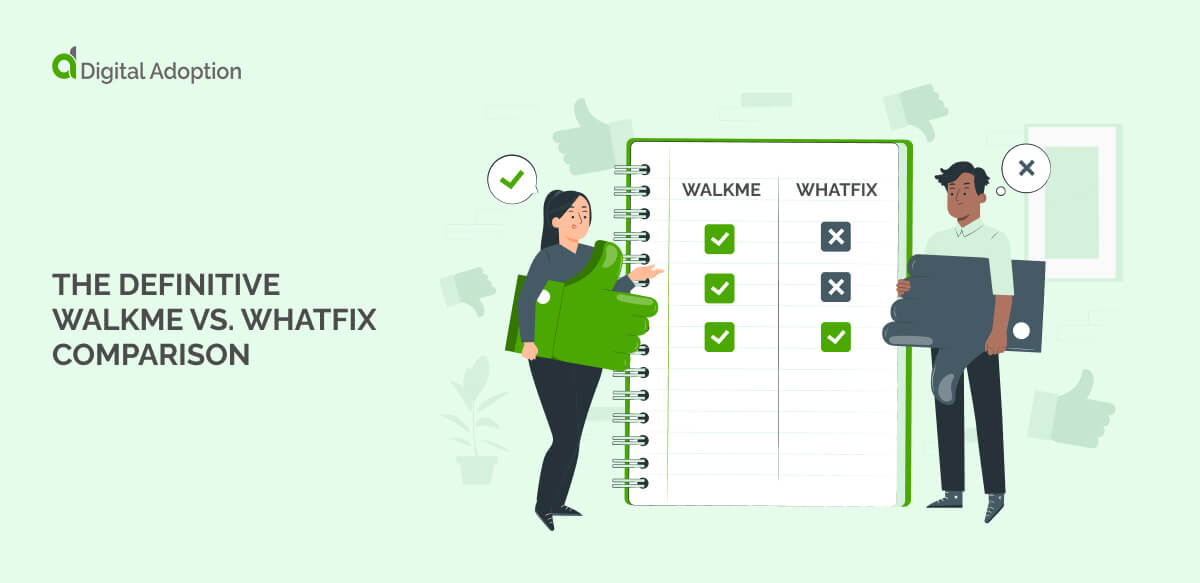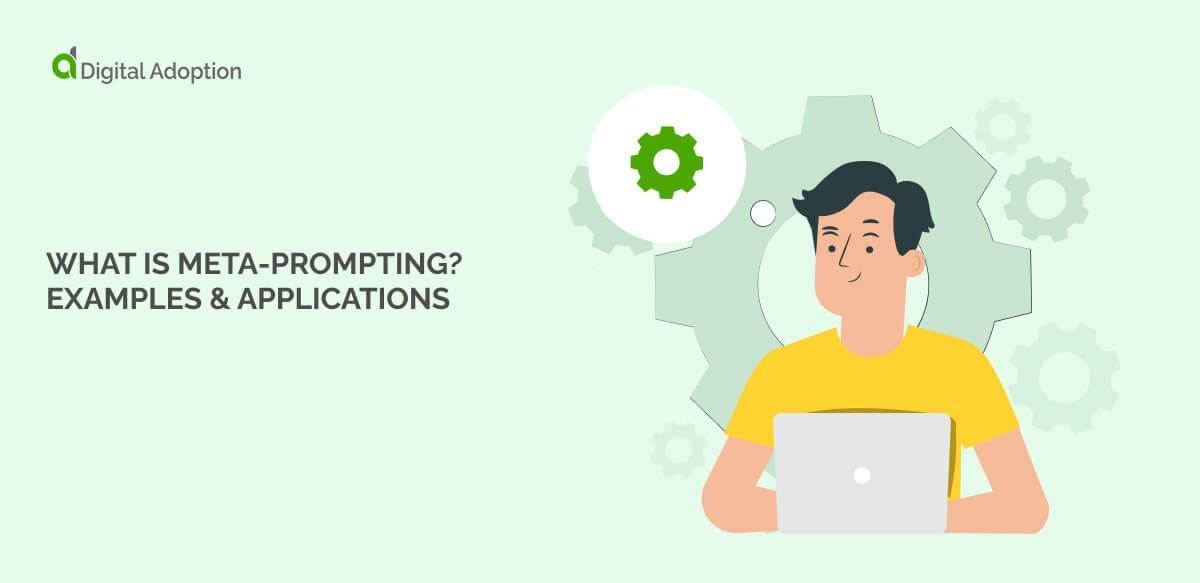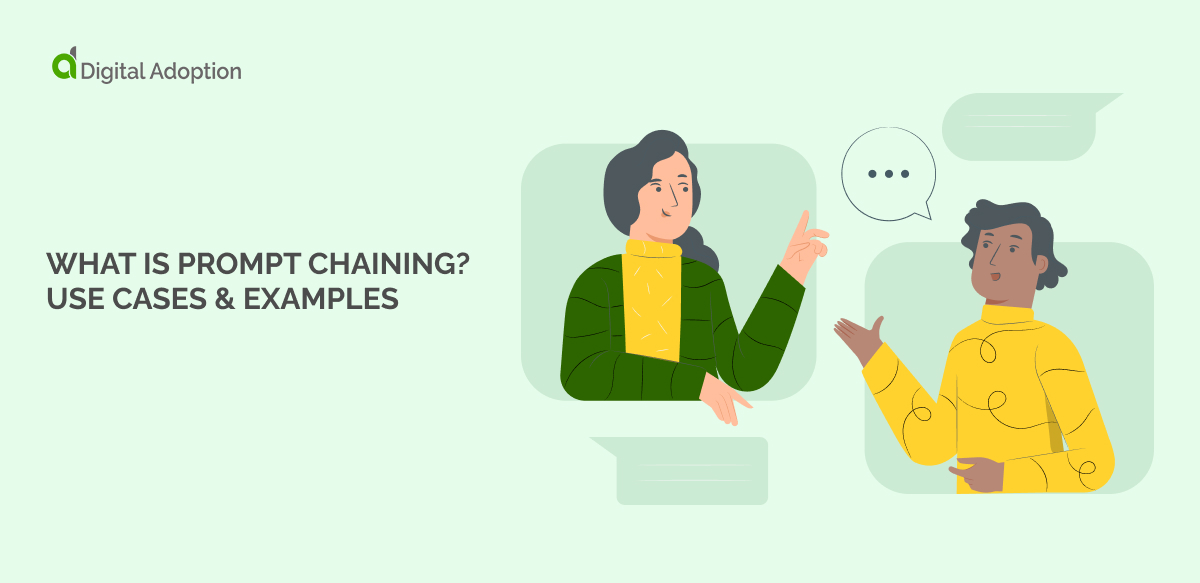Digital Adoption Platform (DAP) can significantly improve an organization’s efficiency and productivity. This is a comprehensive comparison of two leading options: WalkMe and Whatfix. Both platforms offer unique capabilities, from analytics and workflow configuration to personalization and onboarding assistance. This comparison dives into specifics pertaining to feature sets, pricing, and the overall user experience each platform provides.
Whether you are seeking advanced, data-driven features for complex enterprise environments or simplified tools for straightforward onboarding processes, this guide will help you discern which platform offers the most value to your organization. By highlighting the advantages and potential limitations of both platforms, we aim to provide a balanced view to inform your decision-making process.
Please note that this post will be continuously updated to reflect the evolving landscape of technology, market trends, use cases, and feature updates in both WalkMe and Whatfix platforms.
Both WalkMe and Whatfix are well received by users and industry analysts. But not all DAP solutions were created equal. So, how can you know which is right for you? The first step would be to outline your objectives and priorities beyond the need to streamline onboarding and training with walkthroughs.
This may include accessing user behavior insights, automating tasks, applying cross-app analytics, and optimizing software licensing, among others.
Once you’ve got your list in hand, a side-by-side comparison of features, capabilities, and user feedback will go a long way towards helping you gain clarity about which solution is best suited for your organization’s digital adoption needs.
- WalkMe and Whatfix at a glance
- What reviewers say
- What reviewers say
- The lowdown on features: WalkMe vs. Whatfix side-by-side
- WalkMe vs. Whatfix: Data and analytics capabilities
- WalkMe vs Whatfix: Content building capabilities
- WalkMe vs. Whatfix: Automation and workflow support
- WalkMe vs. Whatfix: Enterprise readiness
- WalkMe vs. Whatfix: Customer support
- WalkMe vs. Whatfix: Business value and ROI
- WalkMe vs. Whatfix pricing comparison
- The WalkMe advantage: extending the value of DAP
- WalkMe vs. Whatfix: What is the best digital adoption platform for you?
WalkMe and Whatfix at a glance
WalkMe is long recognized as an industry leader, having received widespread acclaim for its digital adoption platform. Recent accolades include InfoWorld Technology of the Year Award 2022, Software Asset Management Solution of the Year 2023, Forbes Cloud100 World’s Best Cloud Companies, and many more.
The platform is well noted for enabling organizations with effective and fast digital adoption. And the company is also regarded for continually introducing innovations that extend the value of DAP, such as its conversational interface that leverages NLP for chat-based interactions.
Whatfix is well known for offering an affordable platform that performs well on delivering core DAP functionalities. The platform is focused on streamlining software onboarding and providing real-time task guidance for reducing the number of inquiries that the help desk receives.
The Whatfix solution is best suited for organizations that have prioritized quick wins over customization depth and self-serve independence.
What reviewers say
What reviewers say
User sentiment for WalkMe across the leading software review websites is extremely favorable, achieving a nearly perfect score overall, with very high ratings in key criteria, such as ease of use, customer service, and value for money.
Among the most noted ‘likes’ are WalkMe’s comprehensive feature set, enabling non-technical users to build solutions quickly, extensive customization for tailoring experiences for different users and use cases, streamlined workflows, and automated tasks.
Whatfix comes in with solid reviews, earning positive feedback regarding the platform’s overall capabilities and customer service. The offering is noted for its core functionalities for software onboarding and real-time task guidance.
Though it’s important to note that reviewers would like to see more customization options and to avoid the need for technical support when making certain configurations and content updates.
The lowdown on features: WalkMe vs. Whatfix side-by-side
WalkMe vs. Whatfix: Data and analytics capabilities
WalkMe is designed for organizations seeking to embrace data-driven decision-making without excessive time and resource investment. With WalkMe, you can track all data related to digital adoption within your organization. This includes individual user and account usage insights, as well as automated discovery of applications across your tech stack, complete with usage analysis. Additionally, WalkMe offers features such as auto tracking, enabling visualization and analysis of every click, hover, and interaction with pre-selected on-screen elements.
Through WalkMe’s application discovery feature, you can automatically view all applications in your tech stack, including total users, usage duration, and frequency. This helps identify potential areas for cost optimization, app consolidation, and license allocation.
Workflow analytics enable you to understand user interactions within apps in the context of specific tasks, identifying drop-off triggers, and improving process efficiency. With guidance analytics, you can track user engagement with on-screen guidance and predefined elements.
Furthermore, WalkMe provides form completion analytics to uncover insights into user bottlenecks, time wastage, or process abandonment. User interaction playback sessions allow you to capture, analyze, and replay entire user sessions. Finally, WalkMe offers customizable reports, providing deeper and more valuable insights into user experience.
Whatfix’s platform offers guidance analytics and a funnel report (called Flows), shedding light on user behaviors. Additionally, Whatfix offers data and analytics features that provide visibility into user interactions with their guidance, and help identify the most and least used content. This is a key strength, as it enables businesses to understand user behavior and adapt their strategies accordingly. However, several users have noted that these analytics can be somewhat unclear and lack comprehensive insights, indicating room for improvement.
The tool also offers a degree of customization, such as the ability to tailor welcome messages and pop-up triggers, an appreciated feature by users. Despite this, users have expressed a desire for more flexibility in customizing conditions, triggers, and logic that control behaviors. This suggests that while Whatfix’s data and analytics capabilities have strong foundations, they may not fully meet the needs of businesses seeking complex customization and deep analytical capabilities.
Addressing more complex needs requires an IT-level understanding of how data is tracked and monitored. Moreover, while the organization can get reports on user interactions, discovering applications and related interactions is coding intensive.
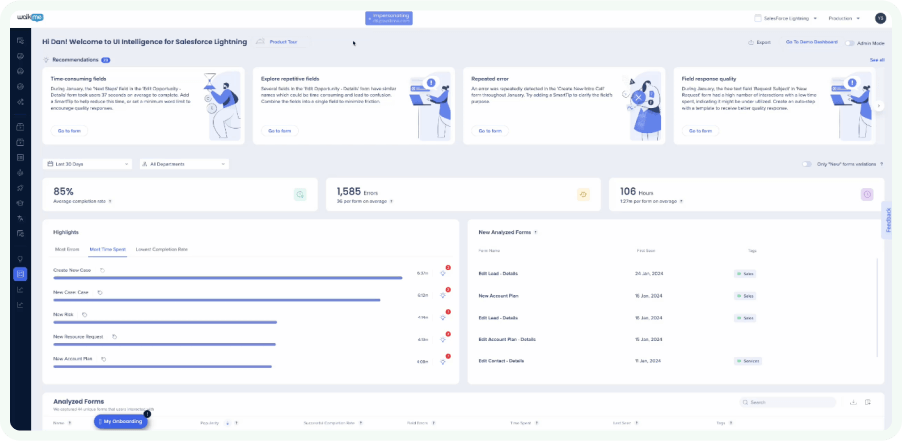
WalkMe vs Whatfix: Content building capabilities
WalkMe and Whatfix both offer notable content-building capabilities, but there are some distinct differences between the two. WalkMe excels with its ease of use and robust personalization options. Its user-friendly platform employs an intuitive drag-and-drop interface, coupled with detailed guides and tutorials, which makes it an accessible tool for non-technical users.
WalkMe supports complex business logic and processes with configurable user workflow templates. Users can select the user workflow that aligns to their organization’s most pressing business issue, choose the relevant tasks, and then easily configure and customize WalkMe in-app guidance content to their needs.
The platform’s superior personalization capabilities stand out, allowing users to tailor their walkthroughs based on user preferences, roles, and behavior, facilitating a more engaging and relevant user experience. Additionally, WalkMe goes a step further with its advanced segmentation and branching capabilities, enabling users to create unique paths based on user responses or behavior.
WalkMe’s broad language support also makes it a suitable option for global businesses that need to create and manage content across various regions and user groups.
On the other hand, Whatfix is equally praised for its intuitive interface and easy-to-use editor. Users appreciate the platform’s straightforward content creation and management capabilities, as well as the quick setup process; however, some have noted a learning curve associated with more advanced customizations.
Whatfix also offers personalization options, such as custom welcome messages and user-role-based guided tours, but users have shown interest in a deeper level of personalization capabilities. Whatfix provides segmentation features, allowing content to be customized for different user segments, but lacks the depth of WalkMe’s branching capabilities. Lastly, while Whatfix does support multiple languages, a bonus for international customers, some users have reported occasional issues with translation accuracy.
WalkMe vs. Whatfix: Automation and workflow support
WalkMe offers robust automation and workflow support with features such as smart walk-throughs, onboarding flows, and automation bots. The platform excels in providing interactive guides and smart tips to support users throughout their workflow journey. Additionally, WalkMe provides easy-to-use tools for creating custom workflows, allowing users to design and implement user paths tailored to their specific needs.
On the other hand, Whatfix also offers interactive guides and smart tips, assisting users in their workflow journey. While it allows for workflow customization, some users have reported limitations in the flexibility of conditions, triggers, and logic that control behaviors. Furthermore, there has been user feedback regarding limitations in the integration capabilities of Whatfix, which may hinder workflow efficiency.
Both WalkMe and Whatfix support task automation, enabling businesses to streamline operations and improve productivity. However, it is important to note that the extent of automation capabilities may vary depending on the specific requirements of the business.
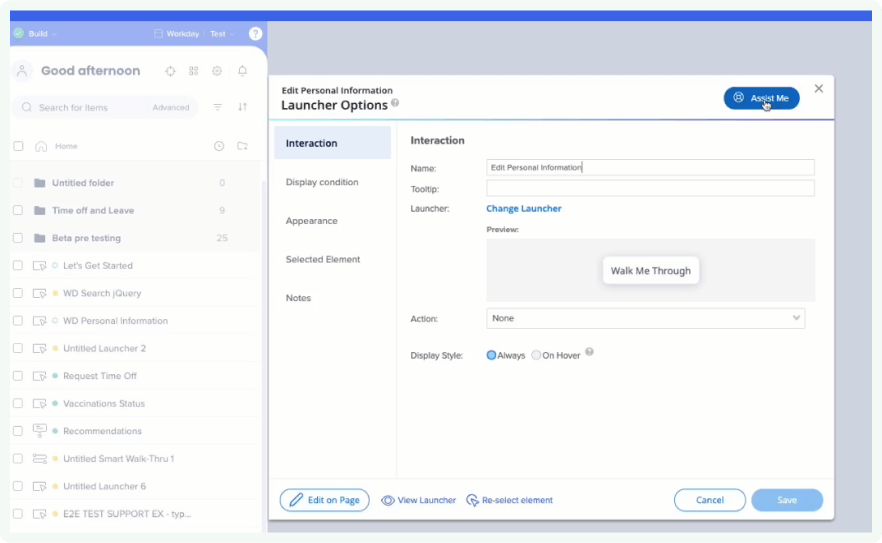
WalkMe vs. Whatfix: Enterprise readiness
WalkMe demonstrates a strong capability in scalability and governance, due to its robust feature set that can easily adapt to diverse enterprise requirements. The platform provides comprehensive analytics and reporting tools, offering insightful data that can inform decision-making processes.
WalkMe has a mature partner and community ecosystem, with many third-party integrations and a highly engaged developer community. The platform also leverages advanced technology, such as ML/AI, to personalize user experiences and streamline processes. However, in terms of change management, WalkMe users have reported challenges in the setup and configuration process, suggesting the need for robust technical support.
WalkMe prides itself on its commitment to data security, demonstrated by its numerous security certifications. The platform is ISO 27001 certified, signifying adherence to international standards for information security management. Furthermore, WalkMe holds the SOC 2 Type II certification, an endorsement of its robust controls for security, availability, and confidentiality. WalkMe is also the only DAP that has achieved Fed-RAMP Ready status, fulfilling the rigorous security and privacy requirements set by the US federal government. The presence of these certifications underscores WalkMe’s commitment to protecting customer data and maintaining a high level of security within its platform.
Whatfix’s enterprise readiness is seen in its advanced technology capabilities, where it employs ML/AI for personalization to enhance the user experience. However, Whatfix falls short in aspects of scalability and governance, mainly due to its limited customization options and a somewhat complex implementation process. Its reporting and analytics capabilities, while helpful, are said to be lacking in depth, limiting the insights gained for data-driven decisions.
Moreover, Whatfix’s partner and community ecosystem shows room for improvement, as users have indicated that the community forums and developer resources could be more active. In terms of change management, reviews suggest that the setup, configuration, and content updates can be challenging, necessitating the need for technical support.
WalkMe vs. Whatfix: Customer support
When comparing WalkMe and Whatfix’s support and customer success, there are several factors to consider. WalkMe is known for its high-quality customer service, with most users praising their quick response times and problem-resolution skills. They offer a wealth of online resources, including video tutorials, webinars, and a comprehensive FAQ section, which are highly appreciated for their usefulness and ease of use. WalkMe also has a vibrant online community where users can engage with each other, find solutions to problems, and share tips and tricks.
On the other hand, Whatfix’s customer support receives mixed reviews. While some users find the response times slow and post-support follow-up lacking, others appreciate the support team’s helpfulness and responsiveness. Whatfix users suggest a need for more comprehensive educational resources and documentation. However, they do provide embedded on-screen help and interactive walkthroughs during onboarding, which are highly valued.
Whatfix does not have a specific community engagement platform or user forum. They do, however, provide a basic community area for discussions, posting tips, and answering customer inquiries.
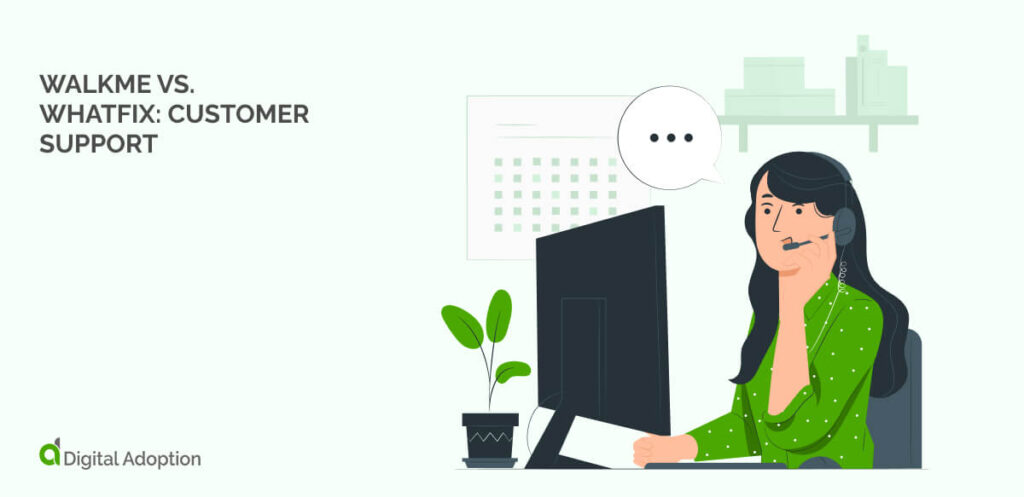
WalkMe vs. Whatfix: Business value and ROI
When evaluating the business value and return on investment (ROI) of WalkMe and Pendo, there are several factors to consider:
WalkMe, with its robust set of features, provides significant business value. Its advanced automation capabilities can lead to substantial time savings for businesses, effectively increasing productivity levels and reducing operational costs. The platform’s detailed analytics can also provide valuable insights into user behavior, enabling businesses to optimize their software usage and improve overall user experience. These improvements can lead to higher customer satisfaction levels, increased customer retention, and ultimately, increased revenue.
In terms of ROI, WalkMe’s users often report a swift return on their investment. The efficiency gains from using the platform can lead to significant cost savings. Furthermore, businesses can expect increased revenue from improved customer satisfaction and engagement, further enhancing the ROI.
Whatfix delivers value to customers through enhanced user experience and measurable impact on ROI. Customers report a significant reduction in training and support costs, faster onboarding, and increased user engagement, all leading to enhanced productivity and performance.
Users also benefit from improved application usability, faster onboarding, and increased user engagement, leading to enhanced productivity and performance. Moreover, the tool’s impact extends to improving sales processes, boosting conversions, and fostering customer independence and self-sufficiency, thus resulting in a positive ROI.
While WalkMe offers a more robust and feature-rich solution, Whatfix provides a more streamlined and cost-efficient alternative.
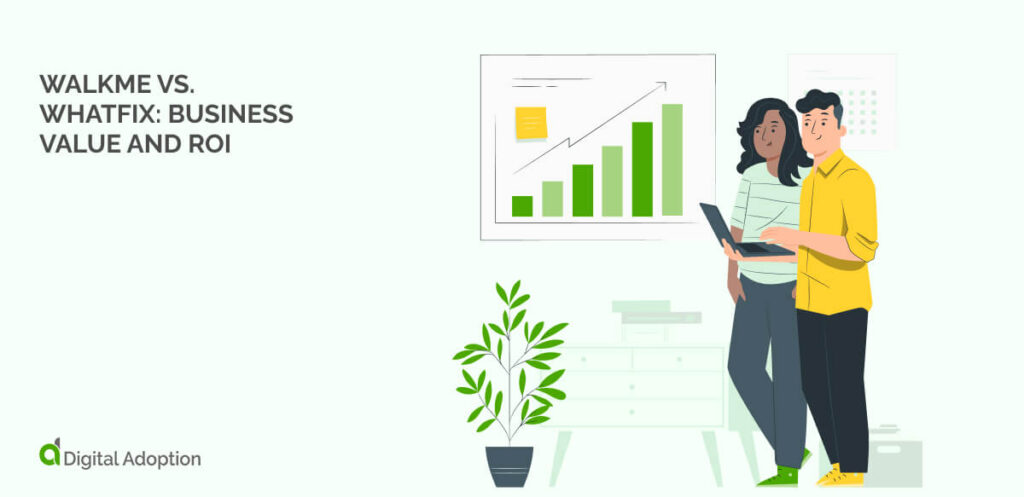
WalkMe vs. Whatfix pricing comparison
WalkMe
WalkMe offers two pricing packages, WalkMe for Employees and WalkMe for Customers. Both are designed to be flexible for accommodating any organization at any stage of the DAP maturity lifecycle as well as for easily picking the package of capabilities and pricing that’s right for them.
The WalkMe for Employees package includes a subscription model for the WalkMe Core offering with optional advanced add-on modules. This approach enables alignment between required features and corresponding pricing, where organizations that need only core features are not required to pay for additional DAP capabilities and functionality.
The WalkMe Core package includes analytics and reporting, interactive in-app guidance, unlimited user workflows, pre-built or bespoke, omnichannel experiences, and admin security controls including access management, privacy settings, and data hosting and residency.
Advanced add-on modules feature expanded DAP capabilities that extend the value of the Core package. Available modules include enterprise analytics, customization and collaboration, connected workplace, and enterprise security.
WalkMe for Customers is a package for customer facing applications. It includes advanced analytics and reporting, interactive in-app guides, tooltips, notifications, a self-serve content creation engine, smart audience targeting, enterprise-grade security, personalized onboarding and product tours, customer sentiment via NPS and surveys, and multi-language support, along with branding and white labeling.
WalkMe also offers a slimmed down, more affordable option called WalkMe Essentials. This is a package that comes at a fixed price with a fixed scope that is ready to roll out in four weeks. It includes up to two pre-built sales and HR workflows which are deployed for one of the following apps – Salesforce, Microsoft Dynamics, Workday, or SAP SuccessFactors, with professional services support.
Whatfix
Whatfix has two main pricing packages – one for DAP and one for product analytics. The DAP package is then further broken down to web, desktop, mobile, and enterprise plans. For a web deployment, there are standard, premium, and pro options. The first two options are designed for employee or customer-facing applications, with the pro option intended for customer facing applications with over one million users.
Each web package option includes features such as in-app guidance, surveys, and content aggregation, with progressively more extensive capabilities depending on the package level. For example, surveys in the standard package are out-of-the-box, but in the premium package they may be customized.
The DAP desktop, mobile, and enterprise packages have two options – standard and premium, both for employee or customer facing applications, and each with a certain features set, based on the level selected.
The enterprise package is the only one that covers an unlimited number of web-based employee-facing applications.
The product analytics pricing package also comes with a standard or premium option. The standard package is designed for a cloud-based deployment plan that is available with any web, desktop, or enterprise plan. The premium package is designed for cloud-based deployment of web-based and desktop-based employee or customer-facing applications.
Among the features available in both are user action tagging, dashboards, funnel insights, event properties, and more, where the standard package allows for 25 tag user actions and the premium option is unlimited.
Pricing for each package is comprised of a flat fee along with user license fees, which are defined as based on the type of user who will access the application.
Whatfix product and service add-ons include out-of-the-box content templates, integrations, and analytics, white-labeling, professional services, and more.
Whatfix offers a free trial to interested organizations.
The WalkMe advantage: extending the value of DAP
WalkMe is the pioneer of DAP. With a transparent overlay it provides in-app guided tours and walkthroughs that assist users both internal and external users of enterprise software, home-grown applications, and digital tools, on any channel including desktop, mobile, and web.
It offers a feature set that is comprehensive yet easy to manage for non-technical users. WalkMe also offers extensive customization options for addressing numerous user types and use cases.
One of the most widely appreciated benefits of WalkMe is how it extends the value and promise of DAP with unique features such as cross-app automation, cross-application analytics and insights, and an ActionBot that is powered by conversational automation.
The Whatfix advantage: quick wins at an affordable price
Whatfix is well positioned for organizations seeking basic capabilities that accelerate enterprise software onboarding within a modest budgetary framework.
The platform offers simplified content creation for deploying real-time task guidance and reducing training and support efforts.
With a range of self-serve features, Whatfix is ideal for teams who prefer a collaborative approach and are open to engaging with the company’s support team to unlock additional capabilities.
WalkMe vs. Whatfix: What is the best digital adoption platform for you?

Bottom line, which is best for you? As was noted in the beginning of the review, it all depends on what you need.
WalkMe is right for you if you have different types of users who need to be onboarded to numerous new apps and digital tools, or their new features, quickly and easily, and on an ongoing basis.
WalkMe is also for you if you’re looking to gain clear, data-driven, and actionable insights into how you can maximize usage and optimize your software investments.
If, on the other hand yours is an organization whose processes are not marked by complexity and you don’t mind workarounds to issues that are specific to your workflows, then Whatfix is for you.
With Whatfix you’ll get straightforward onboarding processes and affordability without the depth and breadth of a wider DAP offering.

